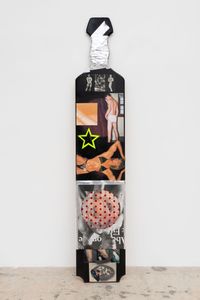
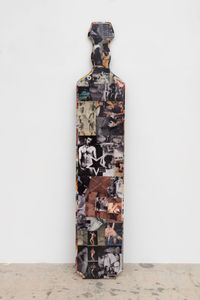
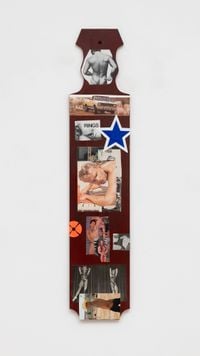
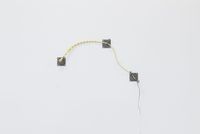
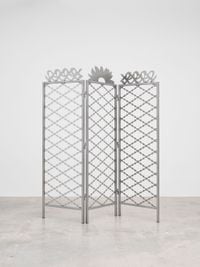
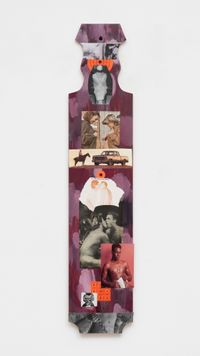
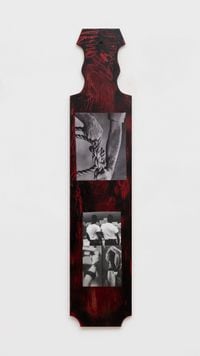
Anat Ebgi is pleased to announce Fratricide, a solo exhibition of new works by Gray Wielebinski. This is the artist's first solo exhibition with the gallery. An opening reception will take place at 6150 Wilshire Blvd, Saturday, October 28 from 5–7pm.
Now you are cursed from the ground, which has opened its mouth to receive your brother's blood from your hand.
—Genesis 4:11
When is violence real? For most of us, the problem this question poses begins in infancy, when, feeling bored, we notice that a sibling sits temptingly within kicking distance. The first, tentative kick elicits a laugh, a half-hearted kick in return. Gradually the kicks become sharper, more ambiguous in tone. Aggressive feelings surface, seemingly out of nowhere. What began as a joke turns into a game, then a competition, then a fight. Gulps of laughter morph into screams and tears. One child calls for mother, while the other submits their plea: We were just playing!
Gray Wielebinski's Fratricide investigates the hazy border between violence and play, love and hate, punishment and pleasure, crystallized in a series of collaged paddles reminiscent of those used in fraternity hazing rituals. Although first recorded as a hazing practice in the late nineteenth century, the popularity of paddling drastically increased after the Second World War, when ex-soldiers brought military rituals into their fraternities. The contemporary backlash against hazing has led many Greek organizations to repurpose paddles as decorative gift objects, a shift Wielebinski seems to emulate in adorning his sculptures with collage. At the same time, the imagery found here—of male beauty, severed body parts, homoeroticism, and tools of discipline—speaks to an entangled legacy of desire, aggression, and humiliation that cannot easily be shaken off.
Wielebinski's practice has long attended to the disavowed homoeroticism within normative American masculinity, whether in the form of a passionate embrace between football teammates or the perfectly sculpted male bodies put to commercial use by Abercrombie & Fitch. With Fratricide, he compels us to attend to the long history of cruelty within which such desires are too often embalmed. Alongside these paddles, Privacy Screen #2, a hauntingly majestic room divider manages to simultaneously evoke an ornate gate, a torture device, and the mundane dystopia of hostile architecture. Playing on the semantic slide between intimacy and private property, the title speaks to the futility of absolute privacy in a hypersecuritized and surveilled world.
Failed attempts at separation lie at the heart of the fratricidal impulse, which inevitably leads into the eerie territory of twins, doubles, and doppelgangers. As literalised by the word itself, homophobia can be understood as fear of the selfsame, a hostility to the repressed desires lying within one's own heart. Terrified of the threat from inside, we erect barriers, hopelessly attempting to curtail our own freedom by forestalling the freedom of others. The psychoanalytic tradition famously traces the root of oppression to the familial scene of conflict and competition. Highlighting 'the fratriarchal dimension of the oppression of women,' the feminist psychoanalyst Juliet Mitchell has emphasised that 'violence against women is initiated by the wish to eradicate a sibling who replaces the toddler as the baby.'
However literally we might take such claims, if violence toward others has any origin in fratricide, then it might be possible to reroute this trope toward a liberatory potential. 'Doppelgängers, by messing with our heads and our illusions of sovereignty, can help teach us this lesson: that we are not as separate from one another as we might think,' Naomi Klein has recently argued. 'Not as individuals, and perhaps not even as groups of individuals who have been born into various kinds of seemingly eternal fratricidal duels.'
Gray Wielebinski (b. 1991 Dallas, TX, USA) received a BA from Pomona College, Claremont CA, USA in 2014 before completing an MFA from the Slade School of Fine Art, London, UK in 2018. Recent exhibitions include: group shows at Goldsmiths Centre for Contemporary Art, London, UK; Francois Ghebaly, Los Angeles, CA; Bold Tendencies, London, UK; and V.O Curations, London, UK. Recent solo exhibitions include: Love and Theft, 12.26 Gallery in Los Angeles, CA; Oil and Water, Hales Gallery in London; and Two Snakes, 12.26 Gallery in Dallas, Texas (2020). Recent residencies include V.O Curations, City and Guilds in London in 2021 and 2019 respectively and at the Academy of Visual Arts in Hong Kong in 2018. His first book 100 Baseball Cards was published with Baron Books in 2022. Wielebinski's work is in the collections of Los Angeles County Museum of Art, CA, and San Francisco Museum of Modern Art Library & Archives, CA. Wielebinski's first institutional solo exhibition The Red Sun is High, the Blue Low is currently on view at ICA London through December 23. Wielebinski lives and works in London, UK.
Press release courtesy Anat Ebgi.
6150 Wilshire Blvd
Mid Wilshire
Los Angeles, 90048
United States
anatebgi.com
+1 (323) 272 - 3418
Tuesday–Saturday
10am–5pm